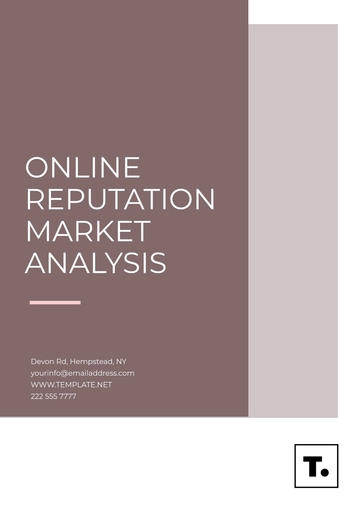Free Hotel Market Analysis

I. Executive Summary
This Hotel Market Analysis provides a comprehensive evaluation of the current market environment, competitive landscape, target demographics, and growth opportunities. The aim is to identify strategic actions to enhance our market position and maximize profitability.
Key Findings
Market Growth: The hospitality industry is projected to grow at an annual rate of 4.5% over the next five years.
Target Demographics: 40% of our guests are aged 30-45, with a preference for luxury and business services.
Competitive Landscape: Our primary competitors hold a combined market share of 55%.
Occupancy Rates: Average occupancy rate stands at 75%, with peak seasons reaching 90%.
Pricing Strategy: Competitive pricing aligns closely with market leaders, with room for strategic adjustments.
II. Introduction
The purpose of this Hotel Market Analysis is to evaluate our market environment, identify key trends, and understand the competitive dynamics. The scope includes an analysis of target demographics, competitor strengths and weaknesses, and potential growth opportunities. Data was collected through industry reports, customer surveys, and market research. This analysis aims to provide actionable insights to inform our strategic planning.
III. Market Overview
The hospitality industry is experiencing steady growth, driven by increased global travel and tourism. Current market trends indicate a shift towards personalized and experience-driven stays. Economic factors such as rising disposable incomes and improved connectivity are contributing to this growth.
Annual industry growth rate: 4.5%
Global tourism growth rate: 5%
Average room rate increase: 3% annually
These figures underscore the robust expansion of the hospitality sector, presenting significant opportunities for growth and innovation.
IV. Target Market Analysis
Our primary target market comprises business travelers and affluent tourists seeking luxury accommodations and personalized services. Understanding their demographics and needs is crucial for tailoring our offerings and marketing strategies.
Demographic | Percent | Key Needs and Preferences |
|---|---|---|
Age 18-29 | 25% | Affordable luxury, social spaces |
Age 30-45 | 40% | Business services, high-speed internet |
Age 46-60 | 20% | Comfort, relaxation, wellness facilities |
Age 60+ | 15% | Accessibility, concierge services |
Our analysis indicates that the largest segment (40%) comprises guests aged 30-45, who prioritize business-related services and connectivity. This insight will guide our service enhancements and marketing efforts.
V. Competitive Analysis
Identifying and analyzing key competitors helps us understand our market position and develop strategies to strengthen our competitive advantage. The table below summarizes the key competitors, their market share, strengths, and weaknesses.
Competitor | Market Share (%) | Strengths | Weaknesses |
|---|---|---|---|
30 | Strong brand recognition | High room rates | |
25 | Affordable pricing | Lower service quality | |
15 | Luxury experience | Smaller market presence |
Our primary competitors collectively hold a 70% market share. Competitor A leads with 30%, leveraging strong brand recognition and extensive amenities. Competitor B offers affordable pricing but suffers from lower service quality. Competitor C provides a luxury experience but has a smaller market presence. Our balanced offering of competitive pricing and quality services positions us well to capture additional market share, particularly from guests seeking value without compromising on quality.
VI. Market Demand Analysis
Understanding market demand trends is crucial for optimizing our occupancy rates and identifying growth opportunities. The table below provides an overview of historical, current, and forecasted demand trends in the hospitality industry.
Historical demand shows a recovery from the pandemic impact, with an upward trend in Year 1 and 2. Current demand is strong at 85%, and forecasted demand suggests continued growth, reaching 92% by Year 7. Key drivers include increasing business travel, a rise in leisure tourism, and improved economic conditions. We will focus on capitalizing on these trends through strategic marketing and service enhancements.
VII. Pricing Strategy Analysis
Effective pricing strategies are essential for maintaining competitiveness and maximizing revenue. The table below compares our pricing with that of key competitors.
Item | Our Price ($) | Competitor A Price ($) | Competitor B Price ($) |
|---|---|---|---|
Standard Room (per night) | 150 | 160 | 140 |
Deluxe Room (per night) | 200 | 220 | 180 |
Suite (per night) | 300 | 350 | 280 |
Breakfast Buffet | 20 | 25 | 18 |
Spa Package | 100 | 120 | 90 |
Our prices are competitive, but there is room to adjust to enhance value perception. We recommend slightly reducing the price of our standard and deluxe rooms to attract more bookings, especially during off-peak seasons. Additionally, introducing bundled packages (e.g., room + breakfast) at a discounted rate could improve occupancy rates and increase ancillary revenue.
VIII. Marketing and Sales Strategies
Effective marketing and sales strategies are key to attracting and retaining guests. Below are the strategies we have implemented:
A. Digital Marketing
Website Optimization: Enhanced our website with user-friendly navigation, high-quality images, and detailed information about our services and amenities. Improved SEO to increase organic traffic.
Social Media Campaigns: Launched targeted campaigns on platforms like Instagram and Facebook to engage potential guests with promotions, guest testimonials, and interactive content.
Email Marketing: Implemented personalized email campaigns to past guests with special offers, updates, and loyalty rewards.
B. Offline Marketing
Print Advertising: Placed ads in travel magazines and local newspapers to reach a broader audience.
Event Sponsorships: Sponsored local events and trade shows to increase brand visibility and attract business travelers.
C. Sales Strategies
Corporate Partnerships: Established partnerships with local businesses to offer corporate rates and packages.
Travel Agency Collaborations: Collaborated with travel agencies to include our hotel in their recommended accommodations, offering exclusive deals for their clients.
Loyalty Program Enhancements: Expanded our loyalty program to include more benefits and rewards, encouraging repeat stays and referrals.
IX. Financial Analysis
A. Revenue Analysis
Our revenue analysis focuses on identifying the main sources of income and evaluating their performance over the past fiscal year. The table below summarizes our revenue streams.
Revenue Source | Revenue ($) | Percentage (%) |
|---|---|---|
Room Bookings | 5,000,000 | 50 |
Food and Beverage | 2,000,000 | 20 |
Spa Services | 1,000,000 | 10 |
Event Hosting | 1,500,000 | 15 |
Other Services | 500,000 | 5 |
Room bookings are the largest revenue contributor, accounting for 50% of total revenue. Food and beverage, and event hosting are also significant sources. There is potential to grow spa services and other ancillary services, which currently make up a smaller portion of our revenue.
B. Cost Structure
Understanding our cost structure is essential for managing expenses and maximizing profitability. The table below outlines our major cost components.
Cost Component | Cost ($) | Percentage (%) |
|---|---|---|
Staffing | 2,500,000 | 40 |
Supplies | 1,200,000 | 20 |
Maintenance | 800,000 | 13 |
Utilities | 600,000 | 10 |
Marketing | 400,000 | 7 |
Other Expenses | 500,000 | 10 |
Staffing constitutes the largest portion of our costs at 40%, followed by supplies and maintenance. Effective cost management strategies, particularly in staffing and supplies, are critical to maintaining profitability.
C. Financial Health
Our financial health is assessed through key financial indicators that provide insights into our overall stability and performance. The table below presents these indicators.
Indicator | Value |
|---|---|
Gross Profit Margin (%) | 55 |
Net Profit Margin (%) | 20 |
Current Ratio | 1.5 |
Debt-to-Equity Ratio | 0.8 |
Our gross profit margin of 55% and net profit margin of 20% indicate healthy profitability. A current ratio of 1.5 suggests good liquidity, and a debt-to-equity ratio of 0.8 indicates a balanced capital structure. These figures reflect a strong financial position with room for strategic investments and growth.
X. Risk Analysis
Identifying and mitigating risks is crucial for sustaining long-term success. The table below outlines key risks, their likelihood, and potential impact.
Risk | Likelihood | Impact |
|---|---|---|
Economic Downturn | High | High |
Competition Increase | Medium | High |
Natural Disasters | Low | High |
Cybersecurity Threats | Medium | Medium |
Regulatory Changes | Medium | Low |
Mitigation Strategies
Economic Downturn: Diversify revenue streams and build a financial reserve to cushion against economic fluctuations.
Competition Increase: Enhance service quality and customer loyalty programs to differentiate our offerings.
Natural Disasters: Implement robust emergency preparedness plans and insurance coverage.
Cybersecurity Threats: Invest in advanced cybersecurity measures and regular staff training.
Regulatory Changes: Stay informed about regulatory developments and ensure compliance through proactive measures.
XI. Recommendations
Based on the analysis, we propose the following strategic recommendations:
Enhance Digital Presence: Invest in digital marketing and SEO to increase direct bookings.
Diversify Revenue Streams: Expand spa services and explore new ancillary services.
Optimize Cost Management: Implement efficient staffing schedules and negotiate better supply rates.
Strengthen Customer Loyalty: Introduce new loyalty program benefits and personalized guest experiences.
Invest in Technology: Upgrade our IT infrastructure to improve cybersecurity and operational efficiency.
Monitor Market Trends: Continuously analyze market trends to adapt and innovate accordingly.
XII. Conclusion
This Hotel Market Analysis highlights our strong market position and financial health while identifying areas for improvement and growth. By implementing the recommended strategies, we can enhance our competitive edge, increase profitability, and ensure long-term success. Our commitment to excellence and adaptability will drive continued growth and guest satisfaction in the dynamic hospitality industry.
- 100% Customizable, free editor
- Access 1 Million+ Templates, photo’s & graphics
- Download or share as a template
- Click and replace photos, graphics, text, backgrounds
- Resize, crop, AI write & more
- Access advanced editor
Template.net's Hotel Market Analysis Template provides a comprehensive, editable, and customizable framework for analyzing market trends, competition, and opportunities. Perfect for strategic planning, this template is editable in our AI Editor tool, allowing you to personalize every aspect to align with your hotel's specific market research needs efficiently and effectively.





























